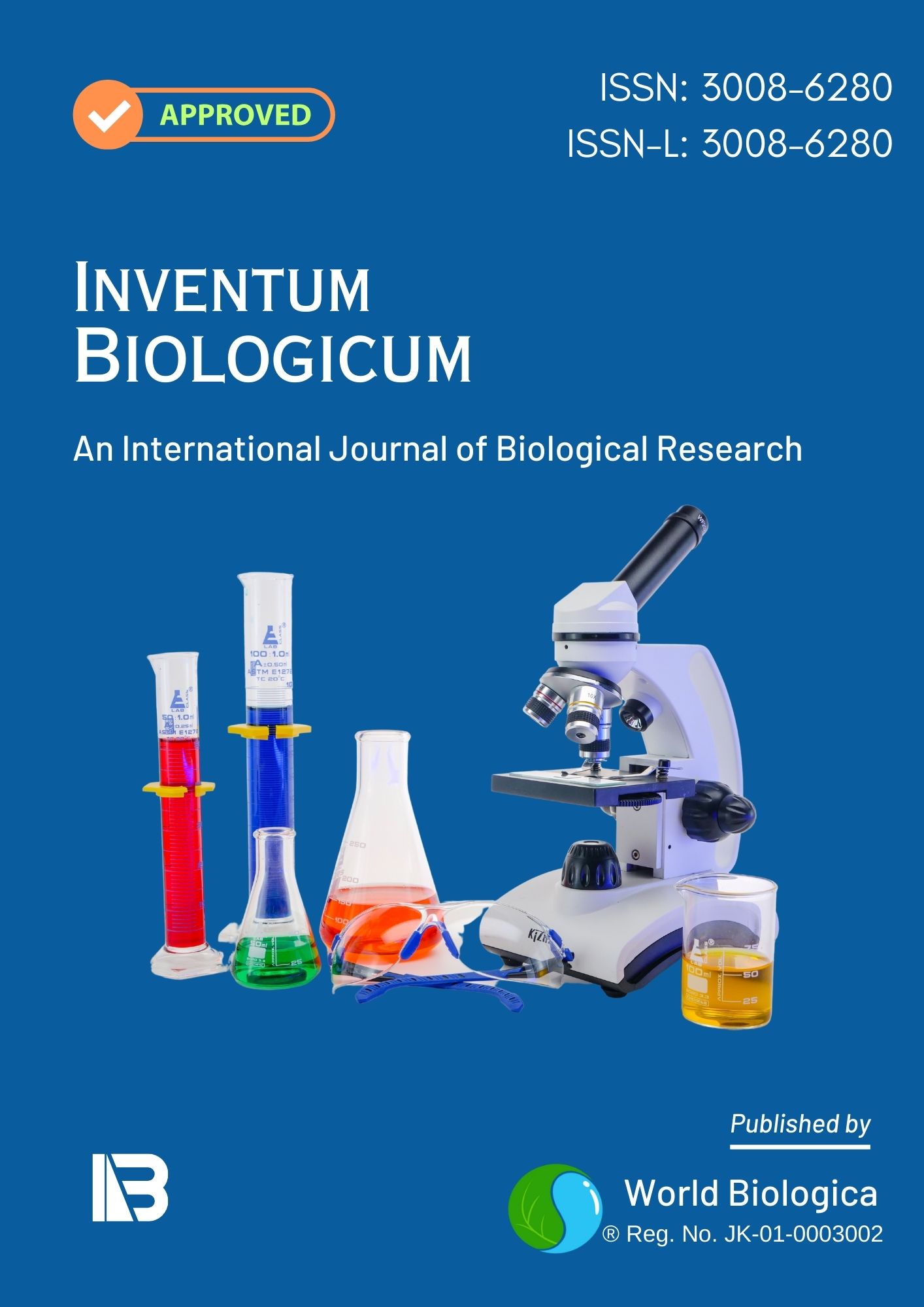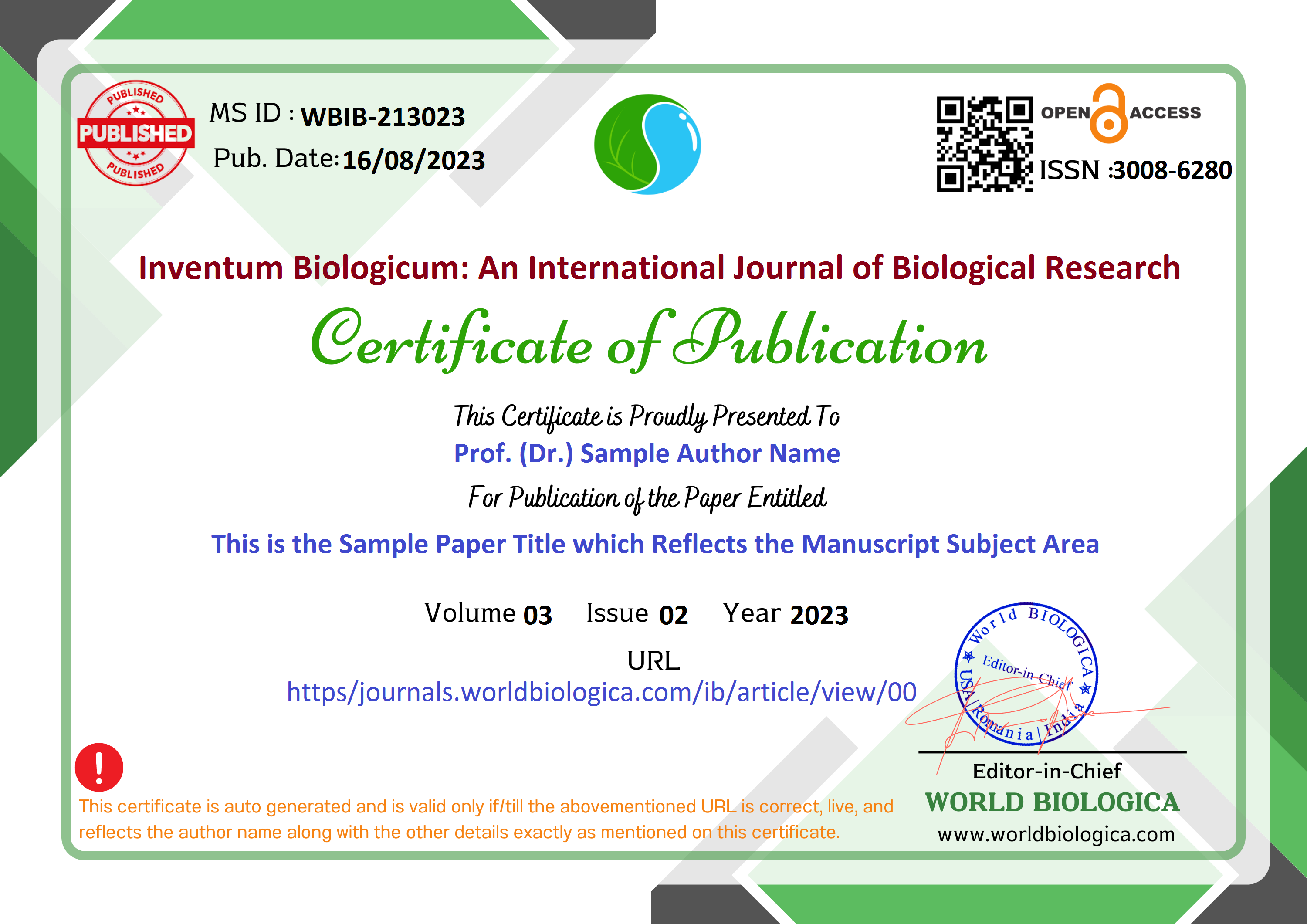Isolation and Characterization of Halophilic Bacteria from Coastal Areas of Odisha, India
Keywords:
Isolation, Salinity, Halophilic bacteria, Biosorption, Heavy metalsAbstract
The current study focuses on the screening and identification of halophilic bacteria from different habitats of Odisha. The halophilic bacteria were isolated and screened with NaCl concentration using 0%-24% (w/v). The selected halophiles were studied for their growth, colony morphology, multi-metal tolerance, sodium capture capacity and biochemical assay. The isolated bacteria were found to be moderately halophilic nature due to the presence of salt such as sodium, magnesium and bicarbonate in the collected samples. The result showed the utmost number of viable cells (0.022 to 1.75 cfu/mL) is due to the hypersaline nature of samples making the bacterial cells suitable to grow under 15%-18% (w/v) NaCl concentration. They were found to be gram-positive and organized in single rods and clusters. The presence of sodium (0.07-0.18 mg/L) were confirmed in the halophiles. The biochemical assay showed all strains are catalase, amylase, urease positive while showed negative results for indole test and cellulose activity. Thus, the findings suggest the existence of halophilic bacteria in the coastal areas of Odisha which can be further studied for their osmotolerant and osmoregulatory properties.
Downloads
References
Akulava, V., Miamin, U., Akhremchuk, K., Valentovich, L., Dolgikh, A. and Shapaval, V. (2022). Isolation, physiological characterization, and antibiotic susceptibility testing of fast-growing Bacteria from the Sea-affected Temporary Meltwater ponds in the Thala Hills Oasis (Enderby Land, East Antarctica). Biol. 11(8): 1143.
Ashwini, K., Gaurav, K., Karthik, L. and Bhaskara Rao, K. V. (2011). Optimization, production and partial purification of extracellular α-amylase from Bacillus sp. marini. Arch. Appl. Sci. Res. 3(1): 33-42.
Baati, H., Amdouni, R., Gharsallah, N., Sghir, A. and Ammar, E. (2010). Isolation and characterization of moderately halophilic bacteria from Tunisian solar saltern. Curr. Microbiol. 60: 157-161.
Baati, H., Siala, M., Azri, C., Ammar, E., Dunlap, C. and Trigui, M. (2022). Genomic analysis of heavy metal-resistant Halobacterium salinarum isolated from Sfax solar saltern sediments. Extremophiles. 26(2): 25.
Bauer, R. K., Stepputtis, D., Gräwe, U., Zimmermann, C. and Hammer, C. (2013). Wind‐induced variability in coastal larval retention areas: a case study on Western Baltic spring‐spawning herring. Fish. Oceanogr. 22(5): 388-399.
Chen, L., Wang, G., Bu, T., Zhang, Y., Wang, Y., Liu, M. and Lin, X. (2010). Phylogenetic analysis and screening of antimicrobial and cytotoxic activities of moderately halophilic bacteria isolated from the Weihai Solar Saltern (China). World J. Microbiol. Biotechnol. 26: 879-888.
Corral, P., Amoozegar, M. A. and Ventosa, A. (2019). Halophiles and their biomolecules: recent advances and future applications in biomedicine. Mar. drugs. 18(1): 33.
Dahlén, G., Hassan, H., Blomqvist, S. and Carlén, A. (2018). Rapid urease test (RUT) for evaluation of urease activity in oral bacteria in vitro and in supragingival dental plaque ex vivo. BMC Oral Health. 18: 1-7.
Damodaran, T., Sah, V., Rai, R. B., Sharma, D. K., Mishra, V. K., Jha, S. K. and Kannan, R. (2013). Isolation of salt tolerant endophytic and rhizospheric bacteria by natural selection and screening for promising plant growth-promoting rhizobacteria (PGPR) and growth vigour in tomato under sodic environment. Afr. J. Microbiol. Res. 7(44): 5082-5089.
Das, P., Chatterjee, S., Behera, B. K., Dangar, T. K., Das, B. K. and Mohapatra, T. (2019). Isolation and characterization of marine bacteria from East Coast of India: functional screening for salt stress tolerance. Heliyon. 5(6).
Delgado-García, M., Contreras-Ramos, S. M., Rodríguez, J. A., Mateos-Díaz, J. C., Aguilar, C. N. and Camacho-Ruíz, R. M. (2018). Isolation of halophilic bacteria associated with saline and alkaline-sodic soils by culture dependent approach. Heliyon. 4(11).
Diba, H., Cohan, R. A., Salimian, M., Mirjani, R., Soleimani, M. and Khodabakhsh, F. (2021). Isolation and characterization of halophilic bacteria with the ability of heavy metal bioremediation and nanoparticle synthesis from Khara salt lake in Iran. Arch. Microbiol. 203: 3893-3903.
Divakar, G., Sameer, R. S. and Bapuji, M. (2018). Screening of multi-metal tolerant halophilic bacteria for heavy metal remediation. Int. J. Curr. Microbiol. App. Sci. 7(10): 2062-2076.
Dookie, S., Jaikishun, S. and Ansari, A. A. (2022). Soil and water relations in mangrove ecosystems in Guyana. Geol. Ecol. Landsc. 1-25.
DuBois, M., Gilles, K. A., Hamilton, J. K., Rebers, P. T. and Smith, F. (1956).
Colorimetric method for determination of sugars and related substances. Anal. chem. 28(3): 350-356.
El Bilali, A., Taleb, A., Nafii, A., Alabjah, B. and Mazigh, N. (2021). Prediction of sodium adsorption ratio and chloride concentration in a coastal aquifer under seawater intrusion using machine learning models. Environ. Technol. Inno. 23: 101641.
Fitri, D. A., Asih, E. N. N., Kartika, A. G. D., Agustina, N., Fadholi, B., Dewi, K. and Efendy, M. (2022). Morphological characteristics of halophilic bacteria in traditional salt production. J. Mar. Resour. Coast. Manag. 3(1): 1-7.
Gharaibeh, M. A., Albalasmeh, A. A., Pratt, C. and El Hanandeh, A. (2021). Estimation of exchangeable sodium percentage from sodium adsorption ratio of salt-affected soils using traditional and dilution extracts, saturation percentage, electrical conductivity, and generalized regression neural networks. Catena. 205: 105466.
Howarth, R. W., Boyer, E. W., Pabich, W. J. and Galloway, J. N. (2002). Nitrogen use in the United States from 1961–2000 and potential future trends. AMBIO: J. Hum. Environ. 31(2): 88-96.
Islam, M. S. and Tanaka, M. (2004). Impacts of pollution on coastal and marine ecosystems including coastal and marine fisheries and approach for management: a review and synthesis. Mar. Pollut. Bull. 48(7-8): 624-649.
Khanafari, A., Khavarinejad, D. and Mashinchian, A. (2010). Solar saltlake as natural environmental source for extraction halophilic pigments. Iran. J. Microbiol. 2(2): 103.
Kumar, B. S. K., Viswanadham, R., Kumari, V. R., Rao, D. B., Prasad, M. H. K., Srinivas, N. and Sarma, V. V. S. S. (2021). Spatial variations in dissolved inorganic nutrients in the groundwaters along the Indian coast and their export to adjacent coastal waters. Environ. Sci. Pollut. Res. 28: 9173-9191.
Layek, M. K., Sengupta, P. and Mukherjee, A. (2019). Erosional features identification along a recently prograding coastal barrier by ground penetrating radar facies analysis: Paradeep, Odisha, India. J. Coast. Conserv. 23: 121-131.
León, M. J., Hoffmann, T., Sánchez-Porro, C., Heider, J., Ventosa, A. and Bremer, E. (2018). Compatible solute synthesis and import by the moderate halophile Spiribacter salinus: physiology and genomics. Front. Microbiol. 9: 108.
Madline, A., Benidire, L. and Boularbah, A. (2021). Alleviation of salinity and metal stress using plant growth-promoting rhizobacteria isolated from semiarid Moroccan copper-mine soils. Environ. Sci. Pollut. Res. 28: 67185-67202.
Matarredona, L., Camacho, M., Zafrilla, B., Bravo-Barrales, G., Esclapez, J. and Bonete, M. J. (2021). The survival of Haloferax mediterranei under stressful conditions. Microorganisms. 9(2): 336.
Mishra, M., Kar, P. K., Chand, P., Mohanty, P. K., Acharyya, T., Santos, C. A. G., Kumar B. and Behera, B. (2023). Deciphering the impact of anthropogenic coastal infrastructure on shoreline dynamicity along Gopalpur coast of Odisha (India): An integrated assessment with geospatial and field-based approaches. Sci. Total Environ. 858: 159625.
Mishra, R. R., Dhal, B., Dutta, S. K., Dangar, T. K., Das, N. N. and Thatoi, H. N. (2012). Optimization and characterization of chromium (VI) reduction in saline condition by moderately halophilic Vigribacillus sp. isolated from mangrove soil of Bhitarkanika, India. J. Hazard. Mater. 227: 219-226.
Mohanty, P. K., Barik, S. K., Kar, P. K., Behera, B. and Mishra, P. (2015). Impacts of ports on shoreline change along Odisha coast. Procedia Eng. 116: 647-654.
Mohapatra, R. K., Parhi, P. K., Thatoi, H. and Panda, C. R. (2017). Bioreduction of hexavalent chromium by Exiguobacterium indicum strain MW1 isolated from marine water of Paradip Port, Odisha, India. Chem. Ecol. 33(2): 114-130.
Mussa, S. A. B., Elferjani, H. S., Haroun, F. A. and Abdelnabi, F. F. (2009). Determination of available nitrate, phosphate and sulfate in soil samples. Int. J. Pharmtech Res. 1(3): 598-604.
Neagu, S., Cojoc, R., Enache, M., Mocioiu, O. C., Precupas, A., Popa, V. T., Gomoiu, I. and Enache, M. (2019). Biotransformation of waste glycerol from biodiesel industry in carotenoids compounds by halophilic microorganisms. Waste. Biomass. Valori. 10: 45-52.
Orji, O. U., Awoke, J. N., Aja, P. M., Aloke, C., Obasi, O. D., Alum, E. U., Udu-Ibiam, O.E. and Oka, G. O. (2021). Halotolerant and metalotolerant bacteria strains with heavy metals biorestoration possibilities isolated from Uburu Salt Lake, Southeastern, Nigeria. Heliyon. 7(7).
Pérez-Inocencio, J., Iturriaga, G., Aguirre-Mancilla, C. L., Ramírez-Pimentel, J. G., Vásquez-Murrieta, M. S. and Álvarez-Bernal, D. (2022). Identification of halophilic and halotolerant bacteria from the root soil of the halophyte Sesuvium verrucosum Raf. Plants. 11(23): 3355.
Pramanik, A., Basak, P., Banerjee, S., Sengupta, S., Chattopadhyay, D. and Bhattacharyya, M. (2016). Metagenomic exploration of the bacterial community structure at Paradip Port, Odisha, India. Genom. Data. 7: 94-96.
Ranasinghe, R. (2016). Assessing climate change impacts on open sandy coasts: A review. Earth-sci. Rev. 160: 320-332.
Rathakrishnan, D. and Gopalan, A. K. (2022). Isolation and characterization of halophilic isolates from Indian salterns and their screening for production of hydrolytic enzymes. Environ. Chall. 6: 100426.
Rengasamy, S. and Thangaprakasam, U. (2018). Isolation, screening and determination of Α-amylase activity from marine Streptomyces species. Int. J. Pharm. Pharm. Sci. 10(4): 122-127.
Rezaeeyan, Z., Safarpour, A., Amoozegar, M. A., Babavalian, H., Tebyanian, H. and Shakeri, F. (2017). High carotenoid production by a halotolerant bacterium, Kocuria sp. strain QWT-12 and anticancer activity of its carotenoid. EXCLI J. 16: 840.
Rohban, R., Amoozegar, M. A. and Ventosa, A. (2009). Screening and isolation of halophilic bacteria producing extracellular hydrolyses from Howz Soltan Lake, Iran. J. Ind. Microbiol. Biotechnol. 36(3): 333-340.
Sahoo, S. and Goli, D. (2020). Bioremediation of lead by a halophilic bacteria Bacillus pumilus isolated from the mangrove regions of Karnataka. Int. J. Sci. Res. 9: 1337-1343.
Satapathy, S. and Panda, C. R. (2018). Source identification, environmental risk assessment and human health risks associated with toxic elements present in a coastal industrial environment, India. Environ. Geochem. Health. 40(6): 2243-2257.
Selvarajan, R., Sibanda, T., Tekere, M., Nyoni, H. and Meddows-Taylor, S. (2017).
Diversity analysis and bioresource characterization of halophilic bacteria isolated from a South African saltpan. Mol. 22(4): 657.
Sharma, A., Dev, K., Sourirajan, A. and Choudhary, M. (2021). Isolation and characterization of salt-tolerant bacteria with plant growth-promoting activities from saline agricultural fields of Haryana, India. J. Genet. Eng. Biotechnol. 19(1): 99.
Shukla, P. J., Nathani, N. M. and Dave, B. P. (2017). Marine bacterial exopolysaccharides [EPSs] from extreme environments and their biotechnological applications. Intl. J. Res. Biosci. 6: 20-32.
Sumit Kumar, S. K., Ram Karan, R. K., Sanjay Kapoor, S. K., Singh, S. P. and Khare, S. K. (2012). Screening and isolation of halophilic bacteria producing industrially important enzymes. Braz. J. Microbiol. 43(4): 1595-1603.
Thompson, J., Barr, C., Babcock-Adams, L., Bird, L., La Cava, E., Garber, A., Hongoh, Y., Liu, M., Nealson, K. H., Okamoto, A., Repeta, D., Suzuki, S., Tacto, C., Tashjian, M. and Merino, N. (2023). Insights into the physiological and genomic characterization of three bacterial isolates from a highly alkaline, terrestrial serpentinizing system. Front. Microbiol. 14: 1179857.
Van Thuoc, D., Loan, T. T. and Tra, N. T. (2021). Accumulation of ectoines by halophilic bacteria isolated from fermented shrimp paste: An adaptation mechanism to salinity, temperature, and Ph stress. Curr. Microbiol. 78: 2355-2366.
Varshney, S., Bhattacharya, A. and Gupta, A. (2023). Halo-alkaliphilic microbes as
an effective tool for heavy metal pollution abatement and resource recovery: challenges and future prospects. 3 Biotech. 13(12): 400.
Weinisch, L., Kühner, S., Roth, R., Grimm, M., Roth, T., Netz, D. J., Pierik, A. J. and Filker, S. (2018). Identification of osmoadaptive strategies in the halophile, heterotrophic ciliate Schmidingerothrix salinarum. PLoS Biol. 16(1): e2003892.
Yancey, P. H. (2005). Organic osmolytes as compatible, metabolic and counteracting cytoprotectants in high osmolarity and other stresses. J. Exp. Biol. 208(15): 2819-2830.
Žilinskas, G., Janušaitė, R., Jarmalavičius, D. and Pupienis, D. (2020). The impact of Klaipėda Port entrance channel dredging on the dynamics of coastal zone, Lithuania. Oceanol. 62(4): 489-500.
Downloads
-
Download PDF
 Abstract Views: 188,
Abstract Views: 188,  Download PDF: 77
Download PDF: 77
Published
How to Cite
Issue
Section
License
Copyright (c) 2024 Inventum Biologicum: An International Journal of Biological Research

This work is licensed under a Creative Commons Attribution-NonCommercial-NoDerivatives 4.0 International License.

















